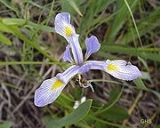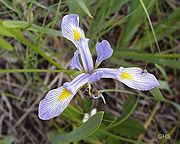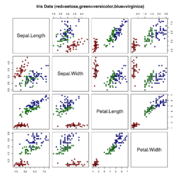
Edgar Anderson
Encyclopedia
Edgar Anderson was an American
botanist. His 1949 book Introgressive Hybridization was an original and important contribution to botanical genetics.
Anderson was born in Forestville, New York
, when he was three his family moved to East Lansing, Michigan
where his father had accepted a position to teach dairy husbandry. In 1914 Anderson entered Michigan State College to study botany and horticulture
. After completing his degree he joined the Naval Reserve and in 1919 he accepted a graduate position at the Bussey Institution of Harvard University
. His studies were supervised by geneticist Edward Murray East
and Anderson worked on the genetics of self-incompatibility
in Nicotiana
. He was awarded a master's degree in 1920 and a DSc in agricultural genetics in 1922.
 He accepted a position as a geneticist at the Missouri Botanical Garden
He accepted a position as a geneticist at the Missouri Botanical Garden
and was appointed assistant professor of botany at Washington University in St. Louis
. His research was focused on developing techniques to quantify geographic variation in Iris versicolor
. In 1929 he received a fellowship to undertake studies at the John Innes Horticultural Institute in Britain, where he worked with cytogeneticist C. D. Darlington
, statistician R. A. Fisher, and geneticist J. B. S. Haldane
. Anderson's data set on three species of irises from the Gaspe peninsula
was used by Fisher as an example with which to demonstrate statistical methods of classification and has subsequently become very well known in the machine learning
community, though often described as Fisher's iris data
.
 Anderson returned to the United States in 1931 and took a position at the Arnold Arboretum at Harvard where he worked with geneticist Karl Sax
Anderson returned to the United States in 1931 and took a position at the Arnold Arboretum at Harvard where he worked with geneticist Karl Sax
. In 1935 he returned to Missouri and in 1937 received the Engelmann Professorship in botany at Washington University. In 1941 he was invited to present the Jesup Lectures at Columbia University
with Ernst Mayr
, discussing the role of genetics on plant systematics, however unlike the other presenters of the Jesup Lectures who later wrote regarded as the foundation of the modern evolutionary synthesis
, he never completed his accompanying manuscript.
He published Introgressive Hybridization in 1949 which described the role of introgression
in speciation. He also wrote the popular science book Plants, Man, and Life which was published in 1952. He was briefly director of the Missouri Gardens in 1954, but returned to teaching in 1957. He retired officially in 1967.
Anderson was a close colleague and friend of Esther Lederberg
http://www.estherlederberg.com. They frequented the Cold Spring Harbor Symposia and had many other colleagues in common, such as J. B. S. Haldane.
Anderson was elected a Fellow of the American Academy of Arts and Sciences
in 1934. In 1954, He was an elected a member of the National Academy of Sciences
. He was also president of the Botanical Society of America
, and was a charter member of the Society for the Study of Evolution
and the Herb Society. He received the Darwin-Wallace Medal
of the Linnean Society.
United States
The United States of America is a federal constitutional republic comprising fifty states and a federal district...
botanist. His 1949 book Introgressive Hybridization was an original and important contribution to botanical genetics.
Anderson was born in Forestville, New York
Forestville, New York
Forestville is a village in Chautauqua County, New York, United States. The population was 770 at the 2000 census.The Village of Forestville is within the Town of Hanover and in the northeast part of the county....
, when he was three his family moved to East Lansing, Michigan
East Lansing, Michigan
East Lansing is a city in the U.S. state of Michigan. The city is located directly east of Lansing, Michigan, the state's capital. Most of the city is within Ingham County, though a small portion lies in Clinton County. The population was 48,579 at the time of the 2010 census, an increase from...
where his father had accepted a position to teach dairy husbandry. In 1914 Anderson entered Michigan State College to study botany and horticulture
Horticulture
Horticulture is the industry and science of plant cultivation including the process of preparing soil for the planting of seeds, tubers, or cuttings. Horticulturists work and conduct research in the disciplines of plant propagation and cultivation, crop production, plant breeding and genetic...
. After completing his degree he joined the Naval Reserve and in 1919 he accepted a graduate position at the Bussey Institution of Harvard University
Harvard University
Harvard University is a private Ivy League university located in Cambridge, Massachusetts, United States, established in 1636 by the Massachusetts legislature. Harvard is the oldest institution of higher learning in the United States and the first corporation chartered in the country...
. His studies were supervised by geneticist Edward Murray East
Edward Murray East
Edward Murray East was an American plant geneticist, botanist and agronomist. He is known for his experiments that led to the development of hybrid corn. He worked at the Bussey Institute of Harvard University where he performed a key experiment showing the outcome of crosses between lines that...
and Anderson worked on the genetics of self-incompatibility
Self-incompatibility in plants
Self-incompatibility is a general name for several genetic mechanisms in angiosperms, which prevent self-fertilization and thus encourage outcrossing...
in Nicotiana
Nicotiana
Nicotiana is a genus of herbs and shrubs of the nightshade family indigenous to North and South America, Australia, south west Africa and the South Pacific. Various Nicotiana species, commonly referred to as tobacco plants, are cultivated and grown to produce tobacco. Of all Nicotiana species,...
. He was awarded a master's degree in 1920 and a DSc in agricultural genetics in 1922.

Missouri Botanical Garden
The Missouri Botanical Garden is a botanical garden located in St. Louis, Missouri. It is also known informally as Shaw's Garden for founder Henry Shaw, a botanist and philanthropist.-History:...
and was appointed assistant professor of botany at Washington University in St. Louis
Washington University in St. Louis
Washington University in St. Louis is a private research university located in suburban St. Louis, Missouri. Founded in 1853, and named for George Washington, the university has students and faculty from all fifty U.S. states and more than 110 nations...
. His research was focused on developing techniques to quantify geographic variation in Iris versicolor
Iris versicolor
Iris versicolor, also commonly known as the Harlequin Blueflag, Larger Blue Flag, Northern Blue Flag, and other variations of those names, is a species of Iris native to North America where it is common in sedge meadows, marshes, and along streambanks and shores.-Growth:I. versicolor is a perennial...
. In 1929 he received a fellowship to undertake studies at the John Innes Horticultural Institute in Britain, where he worked with cytogeneticist C. D. Darlington
C. D. Darlington
Cyril Dean Darlington FRS was an English biologist, geneticist and eugenicist, who discovered the mechanics of chromosomal crossover, its role in inheritance, and therefore its importance to evolution.-Early life:...
, statistician R. A. Fisher, and geneticist J. B. S. Haldane
J. B. S. Haldane
John Burdon Sanderson Haldane FRS , known as Jack , was a British-born geneticist and evolutionary biologist. A staunch Marxist, he was critical of Britain's role in the Suez Crisis, and chose to leave Oxford and moved to India and became an Indian citizen...
. Anderson's data set on three species of irises from the Gaspe peninsula
Gaspé Peninsula
The Gaspésie , or Gaspé Peninsula or the Gaspé, is a peninsula along the south shore of the Saint Lawrence River in Quebec, Canada, extending into the Gulf of Saint Lawrence...
was used by Fisher as an example with which to demonstrate statistical methods of classification and has subsequently become very well known in the machine learning
Machine learning
Machine learning, a branch of artificial intelligence, is a scientific discipline concerned with the design and development of algorithms that allow computers to evolve behaviors based on empirical data, such as from sensor data or databases...
community, though often described as Fisher's iris data
Iris flower data set
The Iris flower data set or Fisher's Iris data set is a multivariate data set introduced by Sir Ronald Aylmer Fisher as an example of discriminant analysis...
.

Karl Sax
Karl Sax was an American botanist and geneticist, in particular he was noted for his research in cytogenetics and the effect of radiation on chromosomes....
. In 1935 he returned to Missouri and in 1937 received the Engelmann Professorship in botany at Washington University. In 1941 he was invited to present the Jesup Lectures at Columbia University
Columbia University
Columbia University in the City of New York is a private, Ivy League university in Manhattan, New York City. Columbia is the oldest institution of higher learning in the state of New York, the fifth oldest in the United States, and one of the country's nine Colonial Colleges founded before the...
with Ernst Mayr
Ernst Mayr
Ernst Walter Mayr was one of the 20th century's leading evolutionary biologists. He was also a renowned taxonomist, tropical explorer, ornithologist, historian of science, and naturalist...
, discussing the role of genetics on plant systematics, however unlike the other presenters of the Jesup Lectures who later wrote regarded as the foundation of the modern evolutionary synthesis
Modern evolutionary synthesis
The modern evolutionary synthesis is a union of ideas from several biological specialties which provides a widely accepted account of evolution...
, he never completed his accompanying manuscript.
He published Introgressive Hybridization in 1949 which described the role of introgression
Introgression
Introgression, also known as introgressive hybridization, in genetics is the movement of a gene from one species into the gene pool of another by the repeated backcrossing of an interspecific hybrid with one of its parent species...
in speciation. He also wrote the popular science book Plants, Man, and Life which was published in 1952. He was briefly director of the Missouri Gardens in 1954, but returned to teaching in 1957. He retired officially in 1967.
Anderson was a close colleague and friend of Esther Lederberg
Esther Lederberg
Esther Miriam Zimmer Lederberg was an American microbiologist and immunologist and pioneer of bacterial genetics...
http://www.estherlederberg.com. They frequented the Cold Spring Harbor Symposia and had many other colleagues in common, such as J. B. S. Haldane.
Anderson was elected a Fellow of the American Academy of Arts and Sciences
American Academy of Arts and Sciences
The American Academy of Arts and Sciences is an independent policy research center that conducts multidisciplinary studies of complex and emerging problems. The Academy’s elected members are leaders in the academic disciplines, the arts, business, and public affairs.James Bowdoin, John Adams, and...
in 1934. In 1954, He was an elected a member of the National Academy of Sciences
United States National Academy of Sciences
The National Academy of Sciences is a corporation in the United States whose members serve pro bono as "advisers to the nation on science, engineering, and medicine." As a national academy, new members of the organization are elected annually by current members, based on their distinguished and...
. He was also president of the Botanical Society of America
Botanical Society of America
The Botanical Society of America represents professional and amateur botanists, researchers, educators and students in over 80 countries of the world...
, and was a charter member of the Society for the Study of Evolution
Society for the Study of Evolution
The Society for the Study of Evolution is a professional organization of evolutionary biologists. It was formed in the United States in 1946 to promote evolution and the integration of various fields of science concerned with evolution and to organize the publication of a scientific journal to...
and the Herb Society. He received the Darwin-Wallace Medal
Darwin-Wallace Medal
The Darwin–Wallace Medal is a medal awarded by the Linnean Society of London for "major advances in evolutionary biology". Historically, the medals have been awarded every 50 years, beginning in 1908...
of the Linnean Society.

